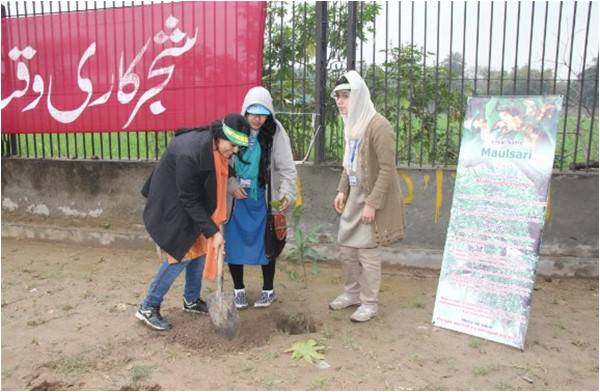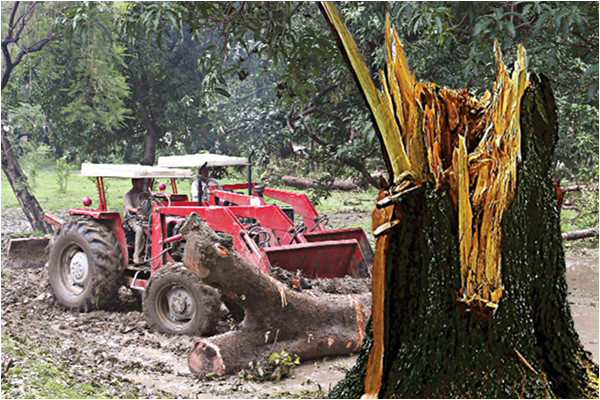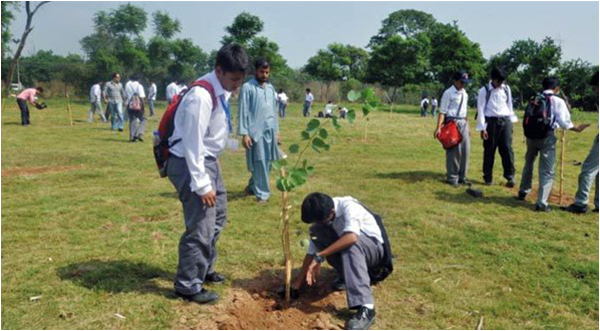
If you are an individual who is passionate to plant trees around the city, belong to a college environmental society or are part of a community group planning to host a tree plantation drive, this article has some useful tips that will help you plan and execute it.
As I write this, I am sitting on the dusty floor of a government school in the North Nazimabad area of Karachi. We have been coming here for past two weeks, almost every day, to prepare for the first school urban forest plantation that is scheduled for today. The building next to the school is blessed with decades-old dates, neem, mango, imli and cheeku trees but on this side, there is a long narrow 36 by 370 feet plot that has a few bair trees and many wild bushes growing. The building kept adding smaller blocks within a narrow plot, much like a railroad arrangement. One has to walk through a 3 feet wide dark, visibly endless path – passing through one building after the next, to reach this almost barren plot.
Although, we had a foolproof plan, a carefully thought-out timeline, budgets approved and a strong team of volunteers to help us out, we have faced unexpected but avoidable situations. Here are some lessons we learned the hard way. Perhaps they will help you!

Be it a school, a public space or your neighborhood; make sure you have done your homework before you start planting. Start by contacting the relevant authorities, do a survey, talk to people who will benefit from the trees and assign goals for what you hope to plant.
If it is a school that you are working with, make sure that you include the management’s ideas and suggestions in your plan. Find out if they have the permission to grow trees, if there is a water supply available and if they have any future plans for construction that may involve cutting down these trees. Take their help in selecting a group of dedicated students who will, ideally, take part in regular watering of the trees. Be sure that their gardener is onboard as well!
Government schools are usually more challenging to work with because of the complex procedures involved and the permissions required from the concerned departments. The Principal is not in charge in most of these cases. You will have to find a way to reach out to all the officials and convince them with a proposal that arouses their interest as well.
Neighborhood plantations, on the other hand, are a perfect way to bond with neighbours and make your community stronger. Talk to neighbours who you have never talked to before: meet in a local park and share your ideas and ask them to suggest theirs. Talk about their favourite trees. You will be surprised by how this brings back beautiful childhood memories. People can instantly get inspired to plant the same tree that is a part of some cherished memory. There may be a few individuals who would want to take up the responsibility for checking on the plants.
Never commit for more than that you can deliver.

If you are driven by the motivation of planting a billion trees on your own, stop and consider few points. We live in cities where there is an absence of water, no implementation of regulations around development, little maintenance of public spaces and little interest from the public in taking care of plants.
You must plan wisely and make partners so as to help you to reach your goal of planting trees. It may take time to identify the right places to plant trees but it will be worth it. Partnering with institutions, community centers, hospitals, local parks and closely-knit communities works best.
There are always people and organisations out there that have the resources but do not have the time or a team to work for them. Talk to people to explore the possibilities. You might be able to find volunteers through various volunteer organisations, CSR funds from banks, companies and organisations and free trees from NGOs. Use social media to engage people. I have always asked people, through my page, to contribute trees and within a few hours, I tend to reach my goal!

It is best to use social media these days to reach out to masses. You plan needs to be well researched and it should reflect that you know what you are doing. Make sure to clearly lay out:
Your plans for the use of native trees that meet the needs of the area
Your partnerships with local communities and groups
Your plan of action and timelines
A self sustaining approach to the design
The difference this project hopes to make
For an individual or a lesser known organisation, it is important to partner with more experienced and well reputed organisations and experts – at least for the first few projects. People will then be more confident in approaching you.
You can ask them to come with a certain tree on the day of plantation, or to send you money. For example, a coconut tree may cost somewhere from around Rs. 300-600. People are willing to contribute trees that will be planted in the memory of their loved ones.
While quoting a budget to a funder, add the GST or the tax that applies on each item and also keep a budget for unexpected expenses.
Take your time to assign responsibilities, talking to people who will document the process, revisiting the venue to make sure nothing has changed, keeping your people on board and making sure there is no confusion.
Source your materials and keep all the receipts. Make sure that all the material is transported to the location one day before the event. Soil, manure and plants must not be kept in the open for more than that. Other materials like cane, ropes and tools can be stored a few days earlier – provided there is a secure place to keep them.
On the day of event, gather everyone and get them going. Make it a fun activity. By the end of it, gather around again to celebrate and thank each other.
For me, the most challenging task is to communicate with random volunteers when my own team is not present! But then, one learns to get things done.
No matter how well designed your plan might be, and how favourable the circumstances might seem, expect the unexpected.
In a future piece, I will write about how to grow your own supply of native trees for future plantation efforts.
Zahra Ali is a sustainability educator, writer and environmentalist. She blogs at cropsinpots.pk. Send in questions about gardening to Zahra@cropsinpots.pk
As I write this, I am sitting on the dusty floor of a government school in the North Nazimabad area of Karachi. We have been coming here for past two weeks, almost every day, to prepare for the first school urban forest plantation that is scheduled for today. The building next to the school is blessed with decades-old dates, neem, mango, imli and cheeku trees but on this side, there is a long narrow 36 by 370 feet plot that has a few bair trees and many wild bushes growing. The building kept adding smaller blocks within a narrow plot, much like a railroad arrangement. One has to walk through a 3 feet wide dark, visibly endless path – passing through one building after the next, to reach this almost barren plot.
Although, we had a foolproof plan, a carefully thought-out timeline, budgets approved and a strong team of volunteers to help us out, we have faced unexpected but avoidable situations. Here are some lessons we learned the hard way. Perhaps they will help you!

I have always asked people, through my page, to contribute trees and within a few hours, I tend to reach my goal!
- Select a plot carefully
Be it a school, a public space or your neighborhood; make sure you have done your homework before you start planting. Start by contacting the relevant authorities, do a survey, talk to people who will benefit from the trees and assign goals for what you hope to plant.
If it is a school that you are working with, make sure that you include the management’s ideas and suggestions in your plan. Find out if they have the permission to grow trees, if there is a water supply available and if they have any future plans for construction that may involve cutting down these trees. Take their help in selecting a group of dedicated students who will, ideally, take part in regular watering of the trees. Be sure that their gardener is onboard as well!
Government schools are usually more challenging to work with because of the complex procedures involved and the permissions required from the concerned departments. The Principal is not in charge in most of these cases. You will have to find a way to reach out to all the officials and convince them with a proposal that arouses their interest as well.
Neighborhood plantations, on the other hand, are a perfect way to bond with neighbours and make your community stronger. Talk to neighbours who you have never talked to before: meet in a local park and share your ideas and ask them to suggest theirs. Talk about their favourite trees. You will be surprised by how this brings back beautiful childhood memories. People can instantly get inspired to plant the same tree that is a part of some cherished memory. There may be a few individuals who would want to take up the responsibility for checking on the plants.
Never commit for more than that you can deliver.

- Always make partners
If you are driven by the motivation of planting a billion trees on your own, stop and consider few points. We live in cities where there is an absence of water, no implementation of regulations around development, little maintenance of public spaces and little interest from the public in taking care of plants.
You must plan wisely and make partners so as to help you to reach your goal of planting trees. It may take time to identify the right places to plant trees but it will be worth it. Partnering with institutions, community centers, hospitals, local parks and closely-knit communities works best.
There are always people and organisations out there that have the resources but do not have the time or a team to work for them. Talk to people to explore the possibilities. You might be able to find volunteers through various volunteer organisations, CSR funds from banks, companies and organisations and free trees from NGOs. Use social media to engage people. I have always asked people, through my page, to contribute trees and within a few hours, I tend to reach my goal!

- Raise funds!
It is best to use social media these days to reach out to masses. You plan needs to be well researched and it should reflect that you know what you are doing. Make sure to clearly lay out:
Your plans for the use of native trees that meet the needs of the area
Your partnerships with local communities and groups
Your plan of action and timelines
A self sustaining approach to the design
The difference this project hopes to make
For an individual or a lesser known organisation, it is important to partner with more experienced and well reputed organisations and experts – at least for the first few projects. People will then be more confident in approaching you.
You can ask them to come with a certain tree on the day of plantation, or to send you money. For example, a coconut tree may cost somewhere from around Rs. 300-600. People are willing to contribute trees that will be planted in the memory of their loved ones.
While quoting a budget to a funder, add the GST or the tax that applies on each item and also keep a budget for unexpected expenses.
- Do execute the plan!
Take your time to assign responsibilities, talking to people who will document the process, revisiting the venue to make sure nothing has changed, keeping your people on board and making sure there is no confusion.
Source your materials and keep all the receipts. Make sure that all the material is transported to the location one day before the event. Soil, manure and plants must not be kept in the open for more than that. Other materials like cane, ropes and tools can be stored a few days earlier – provided there is a secure place to keep them.
On the day of event, gather everyone and get them going. Make it a fun activity. By the end of it, gather around again to celebrate and thank each other.
For me, the most challenging task is to communicate with random volunteers when my own team is not present! But then, one learns to get things done.
No matter how well designed your plan might be, and how favourable the circumstances might seem, expect the unexpected.
In a future piece, I will write about how to grow your own supply of native trees for future plantation efforts.
Zahra Ali is a sustainability educator, writer and environmentalist. She blogs at cropsinpots.pk. Send in questions about gardening to Zahra@cropsinpots.pk

